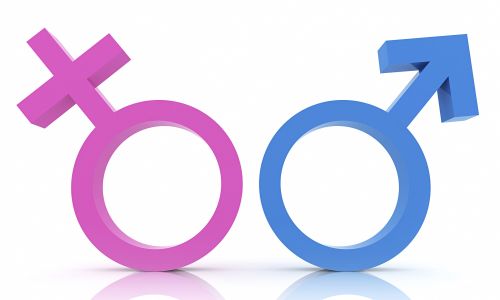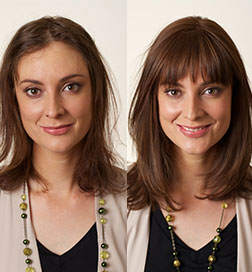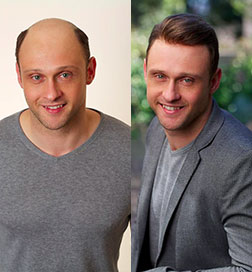
While gender differences have narrowed in so many ways, why is it that when it comes to hair loss, the gap remains wide? A clean-shaven head may be commonplace among men, even trendy (think Bruce Willis and Vin Diesel) but continues to be a rare and ‘brave’ choice for women.
The Fundamental Differences between Male and Female Hair Loss:
Frequency of Hair Loss: Severe hair thinning occurs for about 60 percent of men by age 50 and 40 percent of women by age 40. Hair loss is often wrongly mistaken for a male issue, and as these numbers suggest, more women suffer hair loss than we think. Hair loss and thinning hair most often becomes noticeable at midlife but can even begin in adolescence.
Appearance of Hair Loss: Hair loss in women typically results in all over thinning while male hair loss starts with a receding hairline and often results in complete or near baldness. Women’s hair loss, while diffuse, impacts the crown of the head more than the hairline. Women may notice that their part gradually becomes wider and more of the scalp is exposed.
Causes of Hair Loss: The most common cause behind hair loss is changing hormones, specifically the rising levels of DHT. These hormonal shifts are genetically-determined, occur naturally throughout life, start earlier for men and are exacerbated by menopause in women. Certain stressful life events can also cause hair follicles to prematurely stop growing, particularly in women; and some medical issues can lead to hair loss, like thyroid problems, nutritional deficiency, autoimmune disorders, medications and cancer treatments.
Responses to Hair Loss: When males begin losing their hair they tend to feel anxious about premature aging and have concerns about maintaining their looks. While we see a great number of men here at Transitions Hair, many men also seem to gradually accommodate to their baldness without taking radical measures. However for women, anxiety, even panic, can set in when hair loss strikes. Women not only worry about their attractiveness and desirability, but about their social status and job security.
The Role of Hair throughout History
Even though the role of women in today’s society has broadened dramatically since the Women’s Movement, we are hardwired to respond to the one we had for thousands of years. The male role -to protect and defend, has never been (and probably will never be) connected to his hair where as healthy, youthful looking hair is an integral part of fulfilling a traditional feminine imperative, one that is not likely to disappear anytime soon.
Female beauty icons throughout history also play a part in understanding the gender hair gap. These women have typically had long, thick hair, often portrayed as windswept and wild. Think Elizabeth Taylor, who was known for her black, silky locks and poster girl Farrah Fawcett was all about those blonde waves. Medusa and Rapunzel, while fictional, had hair that served as a symbol of power and classic portraits and sculptures almost always portray women with beautiful, luscious hair. While men have many role models for how to go bald in a confident way, there are only a handful of contemporary women who provide females that kind of inspiration. Baldness in women is just not considered feminine or stylish -and may never be.
What do you think about the gender gap when it comes to hair loss? Leave your comments below!
Don’t forget to click here to book your FREE confidential consultation with one of our hair loss specialists, or call 1300 427 778 for more information.




